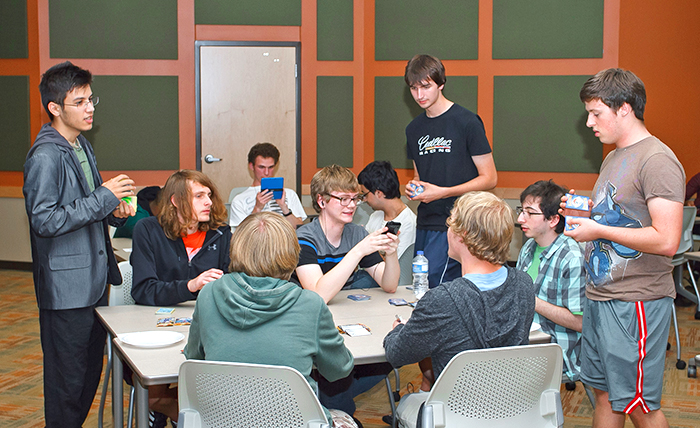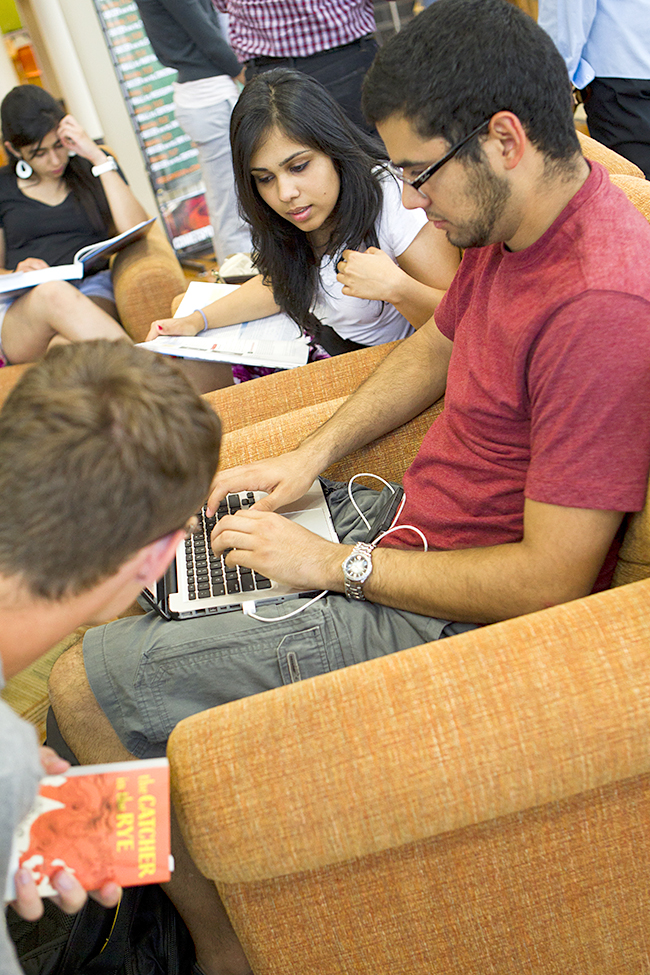
Living Learning Communities are designed to help new students meet and engage with students who have similar interests.
Making the transition from high school to college can feel overwhelming, but UT Dallas’ Living Learning Communities offer new students a ready-made “home” when they set foot on campus.
Organized by academic interest or major, the freshman-year experience gives students the opportunity to live together on the same floor or wing of the University’s Residence Halls, where they can study, take classes together and hang out with like-minded peers.
It’s like a built-in safety net for students who are new to campus, says Mary Jane Partain, director of the Living Learning Communities (LLCs).
“Their home is established before they get here, with students of similar interests and aspirations,” she said.
LLCs are grouped into five academic areas: Arts and Technology, Computer Science, Engineering, Management and Pre-Health. A Social Sciences group will be added in fall 2014.
Peer advisors say their LLC students bond more quickly and more tightly than they would with students of other majors because they often share the same social interests.
Cole McCullar, a junior software engineering major and a peer advisor for the Computer Science LLC this year, said computer science majors are a breed unto themselves.
“Computer science students do click together. They have a logical mindset,” McCullar said.
“I was afraid I would have residents who wouldn’t shower and wouldn’t come out of their rooms. It’s not that way at all,” McCullar said. “They’re still nerdy, but they’re nerdy together. It’s like the inside of a tech company.”

Many students who participate in Living Learning Communities enjoyed a Pokémon Tournament held recently in Residence Hall West. The event drew a large crowd of students from the areas of arts and technology, computer science and engineering.
At any given time, a dozen or more of his computer science students take over the lounge area on their floor, working together on applications, playing the "League of Legends" video game or challenging one another in "Artemis," a multi-computer network game in which players take on Star Trek-like roles.
“That’s my favorite thing to see,” McCullar said.
But the “learning” component of these communities is just as critical, said Shivani Mehta, a neuroscience junior who is a peer advisor for the Pre-Health LLC. Group study times geared toward the classes many of her students are taking – like general chemistry – are invaluable, Mehta said.
“A lot of people don’t know the ropes, what the classes entail. When I was in the Living Learning Community, my (peer advisor) would hand down information that was applicable to my life. I really thought that was a huge advantage,” Mehta said.
“A lot of people don’t know the ropes, what the classes entail. When I was in the Living Learning Community, my (peer advisor) would hand down information that was applicable to my life. I really thought that was a huge advantage.”
Shivani Mehta,
a neuroscience junior who is a peer advisor for the Pre-Health LLC
The concept has been so popular that there is a waiting list to get into Living Learning Communities. This year, 856 freshmen applied for 384 openings. That number will expand in fall 2014, when the program will be housed in the new 600-bed Student Housing Living Learning Center.
Parents are often eager for their kids to apply for an LLC housing spot, as it helps them better adjust to campus life, both academically and socially, Partain said.
“Typically what parents say is, ‘I wish I had this when I was in college,’” said Partain. “There are more eyes on you.”
The LLCs were developed in response to one of the University’s Strategic Initiatives, to help prepare students for the future by providing a holistic learning environment where “the conversation that starts in the classroom doesn’t end there,” Partain said.
Faculty involvement is critical. They host catered dinners at the residence halls and informal game nights. Some prepare “midterm survival boxes” of goodies for students. Others make an effort to meet and greet parents and new students on Freshman Move-In Day.
Dr. Gopal Gupta, head of the Department of Computer Science, became involved with the Living Learning Communities in fall 2012, when a group was formed for computer science and software engineering students.

Some professors have noticed that students in Living Learning Communities appear more comfortable participating in class.
“This gives us access to our freshman students at the entry point,” Gupta said. “They get to know faculty, learn about careers in computer science and probably have less fear of courses and school.”
Dr. Marilyn Kaplan, associate dean of undergraduate education for the Naveen Jindal School of Management, sees a difference in management students who are part of Living Learning Communities.
“You can always tell which class has the LLC students: They enter the classroom talking to each other, they are better prepared for class, and they participate more,” Kaplan said.
LLC students often experience improved retention rates and better grade point averages. Faculty credit the students’ increased comfort level in connecting with faculty and staff for these kinds of results.
“We want to make faculty more human and more approachable. If they’re struggling, they need to know they can come to us,” said Janell Straach, senior lecturer in computer science.
Faculty and staff advisors also arrange for LLC students to visit local industries to meet professionals in their fields.
Management majors have toured the Federal Reserve Bank of Dallas, while computer science students are planning a visit to Match.com, a Dallas-based online dating firm with applications on multiple platforms and a need to manage heavy user traffic.
At Reel FX Creative Studios in Dallas, arts and technology majors were able to talk with animation professionals about what their jobs entail.
“When they see that it takes three months to get four seconds of eye movement in an animated film, it really brings it home,” Partain said.
Although the Living Learning Community model is a freshman-year experience, many participants keep the same roommates year after year, Partain said.
“They’ve spent hours and hours together. It’s a tight bond. We’ve even had some marriages,” she said.